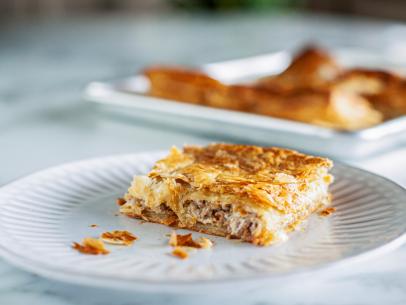Recipe courtesy of Trisha Yearwood
Hard Cider-Braised Sausages with Sauerkraut
Getting reviews...
- Level: Easy
- Total: 1 hr
- Active: 30 min
- Yield: 4 to 6 servings
-
- Nutritional Analysis
- Per Serving
- Serving Size
- 1 of 6 servings
- Calories
- 516
- Total Fat
- 32 g
- Saturated Fat
- 10 g
- Carbohydrates
- 38 g
- Dietary Fiber
- 8 g
- Sugar
- 20 g
- Protein
- 20 g
- Cholesterol
- 74 mg
- Sodium
- 1352 mg
- Level: Easy
- Total: 1 hr
- Active: 30 min
- Yield: 4 to 6 servings
-
- Nutritional Analysis
- Per Serving
- Serving Size
- 1 of 6 servings
- Calories
- 516
- Total Fat
- 32 g
- Saturated Fat
- 10 g
- Carbohydrates
- 38 g
- Dietary Fiber
- 8 g
- Sugar
- 20 g
- Protein
- 20 g
- Cholesterol
- 74 mg
- Sodium
- 1352 mg
Ingredients
Sauerkraut:
Directions
- Heat the olive oil in a large Dutch oven over medium heat. Brown the sausages all over, in batches if necessary, about 5 minutes per batch. Remove to a plate as they brown. Add the onions and cook until softened, about 4 minutes.
- Add the sauerkraut and toss to combine with the onions. Add the thyme, coriander and allspice and stir to combine. Season with pepper. Pour in the cider and reduce by half. Add the stock and brown sugar and return to a simmer. Tuck the sausages back into the pot and simmer, uncovered, until the kraut is very tender and the sauce is flavorful and slightly reduced, 25 to 30 minutes. Season with salt, if needed.
- Bring the sauce to a boil, add the butter and swirl to melt and combine. Serve topped with the parsley.
Sauerkraut:
- Remove any loose leaves from the cabbage head and reserve. Quarter the cabbage and thinly slice, on a mandoline if you have one. (The shreds should be about the thickness of a quarter.) Toss the cabbage in a large bowl with the pickling salt. Work the cabbage through your hands and massage for a minute or two, until the cabbage begins to “sweat” and release some water.
- Thinly slice, then julienne the green apple, leaving the peel on. (Again, use a mandoline if you have one.) Slice the ginger into coins and press with the side of your knife to bruise them slightly and release their oils. Add the apples, ginger and allspice berries to the cabbage and toss well. Let sit for an hour or two, until the cabbage has released quite a bit of water.
- Pack the cabbage mixture into a large, wide-mouthed crock and press down very firmly until the liquid the cabbage has released covers it. (Depending on the age of your cabbage, it may release less water; a fresher cabbage will release a lot of water, while a cabbage that has been stored all winter will release less.) If the cabbage is not covered, mix together 1 quart cold water and 4 1/2 teaspoons pickling salt until dissolved and pour over enough to cover the cabbage.
- Use a couple of the reserved whole cabbage leaves to cover the surface of the cabbage. Cover with a plate (or the weight provided, if you have a fermenting crock) and set something heavy on top to weight it. (You can use cans. Many people like to use a resealable plastic bag filled with the same salted water solution used above because it weights evenly and if it leaks, it doesn’t ruin the fermentation process.) Store the crock in a cool, dry place.
- Check the kraut after 2 days. There should be a few bubbles around the sides. Skim any scum that has risen to the surface. Check the kraut every few days and repeat skimming, if needed. Depending on the temperature of your room, the kraut should be ready after about a week. (Some people ferment for a couple of weeks or more, depending on how funky they want their kraut to be.)
- Divide the kraut and pack into jars. Store in the refrigerator. Drain and rinse the kraut well (discarding any ginger pieces) before using.
Looking for Something Else?
Related Pages
- Ham, Bean and Bacon Soup with Sauerkraut Recipe
- Kielbasa with Sauerkraut Recipe
- Hard Cider Cocktail Recipe
- Braised Pork and Veggie Pockets Recipe
- Garlicky Braised Beef Shanks Recipe
- Stuffed Cabbage with Sauerkraut Recipe
- Sauteed Fish with Sauerkraut Recipe
- Red Cabbage and Apple Sauerkraut Recipe
- Rib Sandwich with Sauerkraut Recipe



































